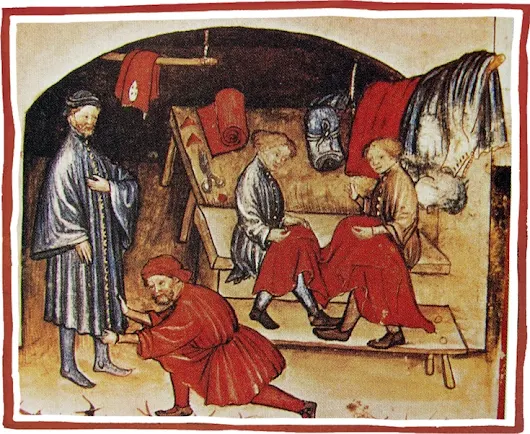Late-14th-Century Guilds and Monopolies
Medieval Guilds and Craft Production
http://employees.oneonta.edu/farberas/arth/ARTH200/artist/guilds.html
The Guild System in the towns, which were the location of trade, manufacturing, crafts, and specializations of various sorts, and which were traded with the people on the Manors for much of the food and related agricultural items that the townspeople needed.
Even with emerging appreciation and recognition of property rights and legal contract relationships for commerce and exchange in the towns, the economic system was one of strict regulation of prices, production, and employment through the craft and professional guilds.
The structure of the Manorial and Guild Systems also meant that the economic focus, the political loyalties, and social relationships tended to be limited to extremely narrow geographical confines. Little attention and few political or economic ties connected the various parts of Europe for the most part during this long period of history – other than the periodic “Free Fairs.”
https://fee.org/articles/how-medieval-towns-paved-the-way-for-capitalism/
Local craft guilds regulated the quality and price of items manufactured in a town, from pewter to barrels or bedcovers, and controlled who could make and sell them. Richer ‘merchant’ guilds controlled wholesale trade in towns, and the most powerful of them (the Merchants of the Staple and the Merchant Adventurers) operated at a national and even international level.
In York (which has the best surviving late medieval records of any English provincial town or city), there were about 60 guilds in the late 15th century. Ranging from bakers, butchers and carpenters to specialist parchment-makers, embroiderers and barber-surgeons, their members – rich and poor alike – were all formally admitted ‘freemen’ of the city. Such a status was almost always earned following a long apprenticeship.
Only freemen could operate their own shop or business in the city. Outsiders could trade only as toll-paying market stall-holders.
Such rigidly restrictive practices were intended to protect local interests. But they also stifled innovation and enterprise, so that commerce increasingly fled the ancient, guild-controlled towns.
http://www.english-heritage.org.uk/learn/story-of-england/medieval-part-2/commerce/
The tailors of London and their guild, c.1300-1500
http://www.medievalists.net/2013/02/the-tailors-of-london-and-their-guild-c-1300-1500/
Medieval Guild, Anyone?
http://kevinclarkcomposer.com/2013/05/medieval-guild-anyone/
When population falls to the degree that it did in Europe during the Black Death years of 1346 to 1353, several things happen. First, the amount of farmland brought under cultivation drops. Second, the price of grain falls because of a decrease in demand. At the same time, wages rise as the number of available workers decreases. In other words, the demand for labor increases, forcing up its price. Other results include a drop in land value and, perhaps, in the cost of non-agricultural goods.
https://guidebookstgc.snagfilms.com/5670_guidebook.pdf
https://www.thegreatcoursesplus.com/films/title/late-14th-century-guilds-and-monopolies


